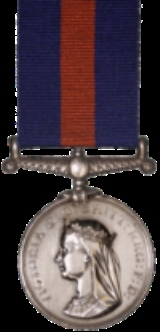
New Zealand Medal
Encyclopedia
The New Zealand Medal was a campaign medal awarded to Imperial and Colonial troops in the New Zealand Wars of 1845-47 (and for 1848) and 1860-66. The New Zealand Wars were previously known as the Maori Wars, Anglo-Maori Wars or Land Wars. The medal was authorised in 1869.
The Imperial forces included British Army, Royal Navy and Royal Marines. The Colonial militia were recruited locally or in Australia, and included mobile forces like Von Tempsky
s Forest Rangers and the Arawa Flying Column from a Māori tribe for the guerilla war in the New Zealand bush. Colonial militia claimants had to prove that they had been under fire. Claims from colonial forces were closed in 1900 but reopened in 1910 and 1913 in association with land claims for service in the war. Claims were finally closed for Europeans in 1915 and Māori in 1916.
(usually) or silver
design with a straight bar suspender. The obverse shows an effigy of Queen Victoria, facing left and wearing a diadem and veil, with the legend: VICTORIA D : G : BRITT : REG : F : D : The bust is similar to but smaller than that on the Abyssinian Medal issued in the same year.
The reverse has a laurel wreath with in centre usually a year or year range from either the first or second period, and between the wreath and the edge NEW ZEALAND (above wreath) and VIRTUTIS HONOR (Honour of valour; below wreath). Generally the colonial militia medals are undated, and a few specimens are known with '1846 to 1865'. A year range is given as ‘1863 / to / 1865’ (in three lines) and unusually for 19th century British medals the year(s) are die struck in the centre.
The blue ribbon has a 10mm red centre stripe. The suspender is ornamented with New Zealand fern fronds. No clasps (bars) were issued.
The Imperial forces included British Army, Royal Navy and Royal Marines. The Colonial militia were recruited locally or in Australia, and included mobile forces like Von Tempsky
Gustavus von Tempsky
Major Gustavus Ferdinand von Tempsky was a Polish-Prussian adventurer, artist, newspaper correspondent and soldier in New Zealand, Australia, California, Mexico and the Mosquito Coast of Central America...
s Forest Rangers and the Arawa Flying Column from a Māori tribe for the guerilla war in the New Zealand bush. Colonial militia claimants had to prove that they had been under fire. Claims from colonial forces were closed in 1900 but reopened in 1910 and 1913 in association with land claims for service in the war. Claims were finally closed for Europeans in 1915 and Māori in 1916.
Description
The medal is a circular bronzeBronze
Bronze is a metal alloy consisting primarily of copper, usually with tin as the main additive. It is hard and brittle, and it was particularly significant in antiquity, so much so that the Bronze Age was named after the metal...
(usually) or silver
Silver
Silver is a metallic chemical element with the chemical symbol Ag and atomic number 47. A soft, white, lustrous transition metal, it has the highest electrical conductivity of any element and the highest thermal conductivity of any metal...
design with a straight bar suspender. The obverse shows an effigy of Queen Victoria, facing left and wearing a diadem and veil, with the legend: VICTORIA D : G : BRITT : REG : F : D : The bust is similar to but smaller than that on the Abyssinian Medal issued in the same year.
The reverse has a laurel wreath with in centre usually a year or year range from either the first or second period, and between the wreath and the edge NEW ZEALAND (above wreath) and VIRTUTIS HONOR (Honour of valour; below wreath). Generally the colonial militia medals are undated, and a few specimens are known with '1846 to 1865'. A year range is given as ‘1863 / to / 1865’ (in three lines) and unusually for 19th century British medals the year(s) are die struck in the centre.
The blue ribbon has a 10mm red centre stripe. The suspender is ornamented with New Zealand fern fronds. No clasps (bars) were issued.

